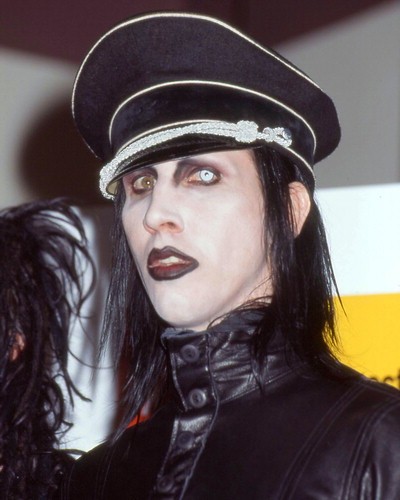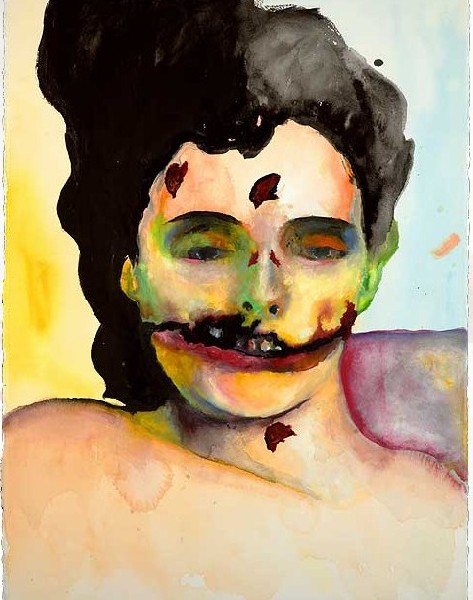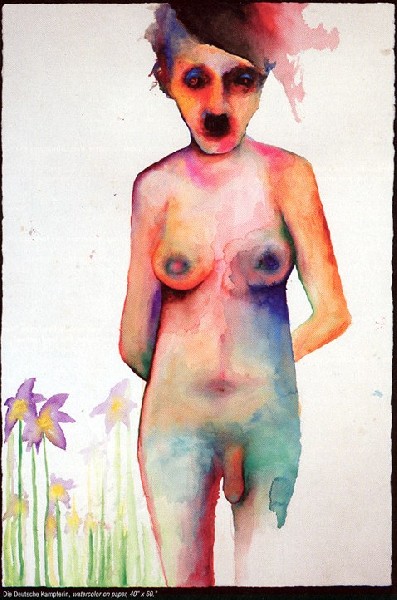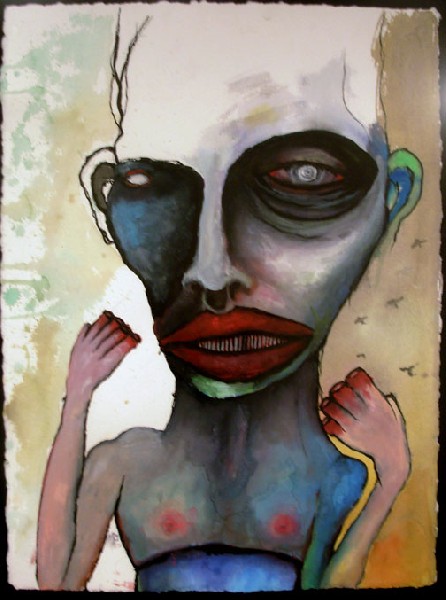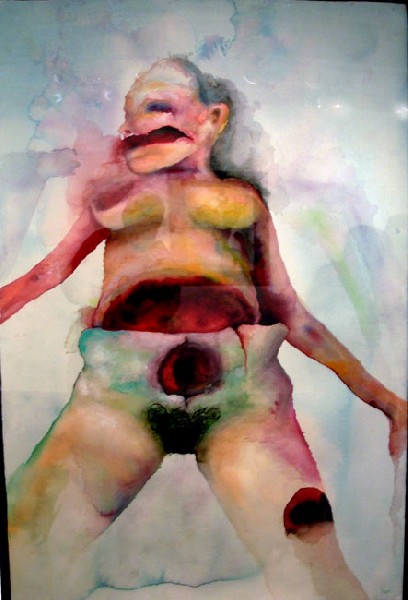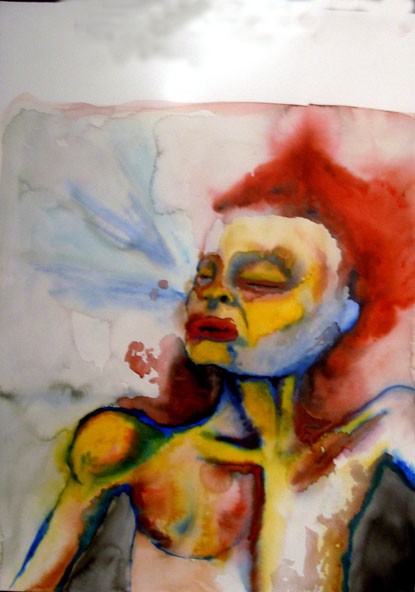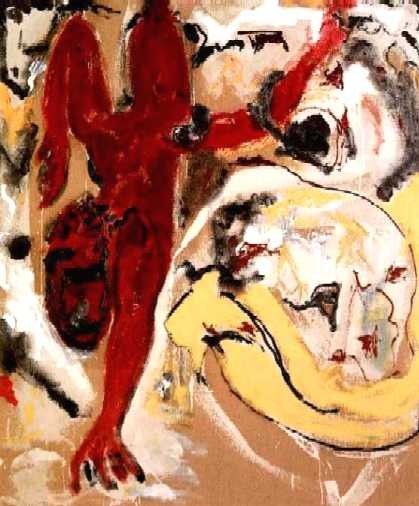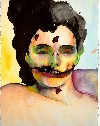Marilyn Manson Watercolors
Brigitte Schenk Gallery at NY Volta Art Fair
By: Charles Giuliano - Mar 16, 2009
The Volta Art Fair during the recent mix of New York Art fairs focused on gallery booths presenting the work, in some depth, of a single artist. Located on the upper floor of a high rise opposite the mid town Empire State Building it offered a range of cutting edge contemporary works. It evoked a different impact from booths in the other fairs which presented a selection of wares from the inventory of a vast range of American and international galleries.
For the most part the Volta strategy proved to be more satisfying in terms of getting a more in depth sense of the most recent experimental work. As we interacted with friends and artists, however, there was some carping about the generally mediocre quality of most of the work presented in Volta. It was, however, a fair and honest representation of what to expect in the emerging art world. Overall, the quality of work in the Volta art fair was light years more significant than the generally piss poor, dreadful, amateurish crap on display at the Fountain and Bridge art fairs. These latter art fairs, within steps from each other on the Hudson River and a short walk from the Chelsea art galleries, evoked the mood of a street fair or summer tent show.
Volta had its surprises, pleasant and not so, but none on the level of encountering the Brigitte Schenk Gallerie from Cologne, Germany which presented several large water colors by Marilyn Manson. Yes, that Marilyn Manson, the ever so strange, androgynous, Goth rock star. On many levels it is appropriate that the work is being presented by a German gallery as Manson's loosely crafted figures and portraits are rooted in the Expressionist tradition.
Scanning the price list we noted that the works cost in the range of $40,000 to $50,000. Especially in this economy that's a lot of money for a celebrity autograph. Mason, who was born Brian Hugh Warner (January 5, 1969, Canton, Ohio), is not the first or last rock star or celebrity to take up painting. Arguably, the best of these is another expressionist, my good buddy, Don van Vliet, who during his rock career was known as Captain Beefheart. Don, on every level, was an amazing artist and it was incredible to hang out with him and his friend Ornette Coleman. One might also note that Talking Heads was formed by students of the Rhode Island School of Design. Even Peter Wolf of the J. Geils band spent some time at the School of the Museum of Fine Arts.
The initial response to the watercolors of Marilyn Manson was to dismiss them as inept celebrity dreck. To resent the fact that fame in another medium served to shoe horn his work into the mainstream of the art world.
But in the process of researching the work it was interesting to discover that some of the same elements that have been structural to the music, of which I have never been a real fan, find their way into the watercolors. Instead of just slap dash art therapy, the initial impulse of encountering his untrained and marginally skilled approach to painting, there were some very strange embedded ideas about gender, alienation, the macabre and fixations on death, doom, and disaster. In essence, the paintings are as Goth as the music and has the same level of appeal to fans and repulsion to mainstream values. On many levels Marilyn Manson has been an idol and template for disenfranchised youth, the Goth kids who stalk the halls of high schools, as well as representing, from a parent/ adult perspective, everything that is wrong with youth nowadays. Perhaps, Manson (who conflated the first name of Marilyn Monroe and the last name of cult killer Charlie Manson) is to his generation what James Dean was to mine. Only, obviously, way more extreme.
On the website devoted to Manson's watercolors we found this artist statement. "I wasn't intending for any of these pieces to be for anybody but myself or the friends that I did portraits of and would give as gifts. I never intended to show them, much less sell them, until several years of paintings built up. And when people would come to my house, they would urge me to show people my art.
"So I took the step and I did it, and I've been quite proud of and surprised by the support and interest, especially from younger fans who may not have gotten into art at such an early age. Maybe this will encourage them to take a look at other things."
On the website I was intrigued by a work called "Die Deutsch Kampferin" from 1999. It seemed typical of Manson's sensibility as it presented a frontal nude figure with breasts, a penis, and the moustache of Charlie Chaplin. Of this work the artist states "The name comes from what I believe was a women's magazine during the Third Reich that was kind of like the Cosmopolitan of propaganda, and it was about being a strong woman for Germany. That painting was sarcastic. I started painting it right when I came home from the Magic Castle, because I'm a member there, and I wanted to do something that tied in '30s Hollywood and Berlin, and Charlie Chaplin was definitely an inspiration.
"I thought the flowers in the background were a cross between columbines, which some people don't know are flowers, and palm trees. It was also around the time of the Columbine event, which I was blamed for. It's so ironic now that the movie, Bowling For Columbine, has made people see how ridiculously the media treated the whole thing. People don't realize how it almost completely destroyed my career. My life was at risk, and I basically wanted to give up. It's great that I've kind of come full circle."
Wiggy man. In the Volta exhibition was a portrait "Elizabeth Short as Snow White (A Smile II)" 2002. It is an image of the woman who was murdered on January 15, 1947. Hacked to pieces actually. She became the famous "Black Dahlia" which inspired a book and movie. In a statement Manson reveals that it is one of his favorite works and he hopes that it is never sold as he would hate to lose it. Many artists feel that way about certain of their works.
No, Manson is not a great artist. But, for his fans, particularly confused and troubled kids, he has managed to catch lightning in a bottle. So who am I to judge that impulse and its resultant work? Better to appreciate any artist willing to plunge into the deepest recesses of the human psyche with its angst, alienation and despair. In my darkest moments I have been there and done that. In that sense we can respect Manson as an artist particularly in his ability to capture the fringe and outer limit of our restive soul.

